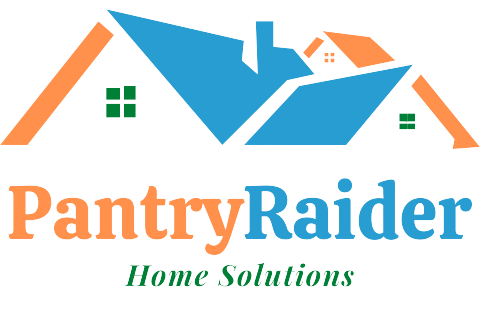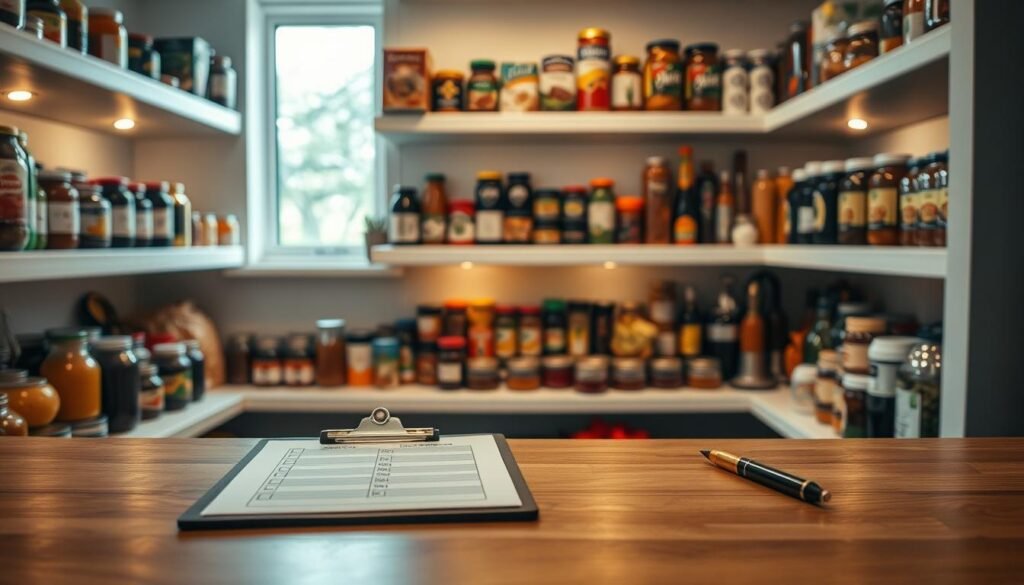
Imagine having a well-organized kitchen where meal prep is a breeze, and food waste is significantly reduced.
Effective inventory management is key to achieving this. By implementing a strategic system, you can save time and reduce waste, making your kitchen more efficient.
This guide will walk you through practical strategies for maintaining a well-stocked kitchen that suits your needs and lifestyle.
Key Takeaways
- Discover how to simplify your kitchen with effective food stocking.
- Learn strategies to reduce food waste and save time.
- Understand the importance of inventory management for home kitchens.
- Explore practical tips for maintaining a well-stocked kitchen.
- Create a personalized system that works for your household.
Your Essential Guide to the Transformative Power of a Food Inventory App!
The Benefits of Strategic Food Stocking
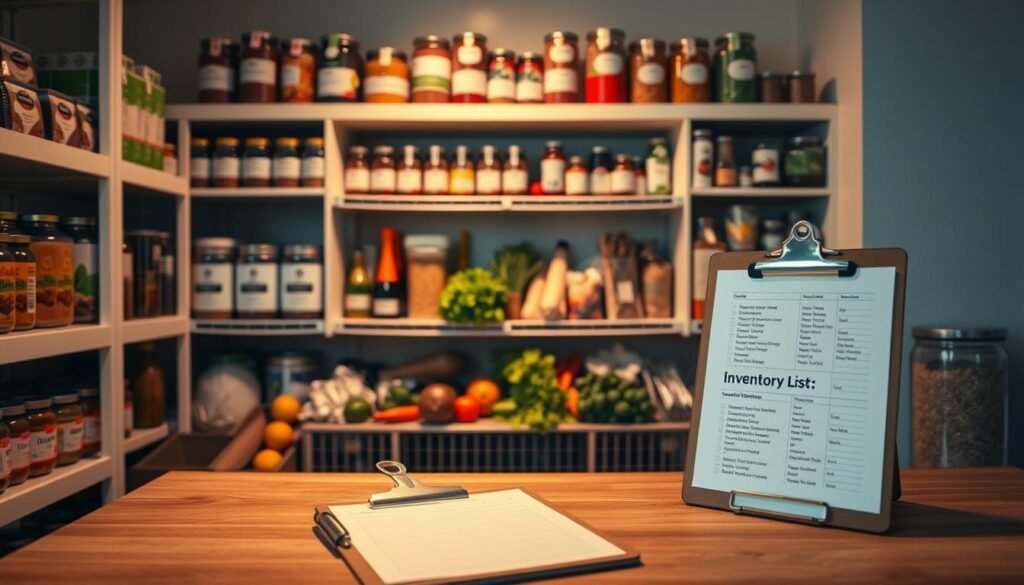
Discover how strategic food stocking can save you time and money while making meal planning more efficient. By implementing a well-planned food inventory system, you can enjoy numerous benefits that make managing your kitchen a breeze.
Saving Money Through Bulk Buying and Reduced Waste
Strategic food stocking allows you to take advantage of bulk buying, reducing your expenses on groceries. By planning your inventory, you minimize food waste, ensuring that every item you purchase is consumed before it expires. This approach not only saves you money but also contributes to a more sustainable kitchen practice.
Saving Time with Fewer Shopping Trips
With a well-stocked kitchen, you significantly reduce the need for frequent shopping trips to the store. This means saving time during the week that would otherwise be spent traveling to and from the store. Initially, organizing your bulk buys may require some extra time, but once your inventory management system is in place, you’ll enjoy the convenience of having everything you need at your fingertips.
| Benefit | Description |
|---|---|
| Saving Money | Bulk buying and reduced waste minimize expenses |
| Saving Time | Fewer shopping trips and efficient meal planning |
By adopting a strategic food stocking strategy, you can enjoy a more organized kitchen, save resources, and make cooking more enjoyable.
Assessing Your Current Kitchen Inventory
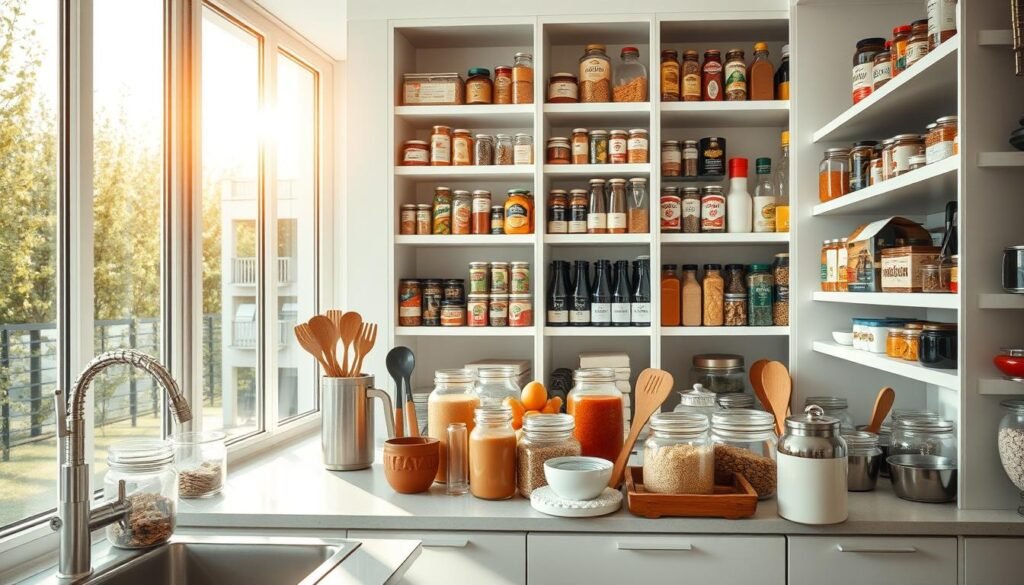
The journey to a simplified kitchen begins with a thorough assessment of your current inventory. You can’t improve what you don’t measure, right? So, let’s dive into understanding what’s currently in your kitchen.
Taking Stock of What You Already Have
Start by taking stock of the food and supplies you already have on hand. Go through your pantry, fridge, and freezer, and make a list of everything. This might seem daunting, but it’s a crucial step in understanding your current inventory and identifying areas for improvement.
As you take stock, consider the concept of “zeroing out” your food supply. This means that once you have two weeks’ worth of food on hand, that’s your new baseline. Think of it like having $500 in your bank account – you’re starting from a known position.
Identifying Gaps and Inefficiencies
After taking inventory, look for patterns that reveal inefficiencies in your current food storage system. Are you consistently throwing away certain items or always running out of others? Identify storage areas that aren’t working well, such as dark corners where food gets forgotten or overcrowded shelves where items get pushed to the back.
- Consider establishing minimum stock levels for staple items your family uses regularly.
- Look for duplicate items scattered throughout different storage areas, indicating a need for better organization and inventory management.
- Pay attention to food waste patterns, as they often reveal gaps in your meal planning or purchasing habits.
By identifying these gaps and inefficiencies, you can start to create a more efficient system for managing your kitchen inventory.
| Current State | Ideal State |
|---|---|
| Cluttered pantry with expired items | Organized pantry with clear labels and rotation |
| Frequent food waste due to overbuying | Minimal waste with a “first in, first out” policy |
| Disorganized storage areas | Efficient storage with easy access to items |
Setting Up Your Food Stocking System
To simplify your kitchen, you need to establish a robust food stocking system. This involves organizing your storage, managing your inventory, and creating a system that works for you.
Choosing the Right Storage Containers
Selecting the appropriate storage containers is crucial for maintaining your food stocking system. Look for containers that are airtight, durable, and easy to clean. Consider the size and shape of your pantry or storage area when choosing containers.
Using the right storage containers can help keep your food fresh and your pantry organized. It’s also important to label your containers clearly to ensure you can easily identify what’s inside.
Creating Zones for Different Food Categories
Creating distinct zones for different food categories transforms your kitchen organization and makes your inventory system intuitive to use. Here are some tips to achieve this:
- Designate specific areas for breakfast items, baking supplies, canned goods, snacks, and other categories that make sense for your household’s eating habits.
- Use clear labeling for both containers and shelves to maintain organization, especially when multiple family members are involved in cooking and shopping.
- Consider frequency of use when creating your zones—items used daily should be most accessible, while occasional ingredients can be stored in less convenient spaces.
- This zoning system makes it easier to take a quick inventory at a glance, helping you maintain proper stock levels without having to search through your entire kitchen.
By implementing these strategies, you’ll be able to manage your food stocking system more effectively, reducing waste and saving time during meal preparation.
Essential Food Stocking Strategies for Home Kitchens
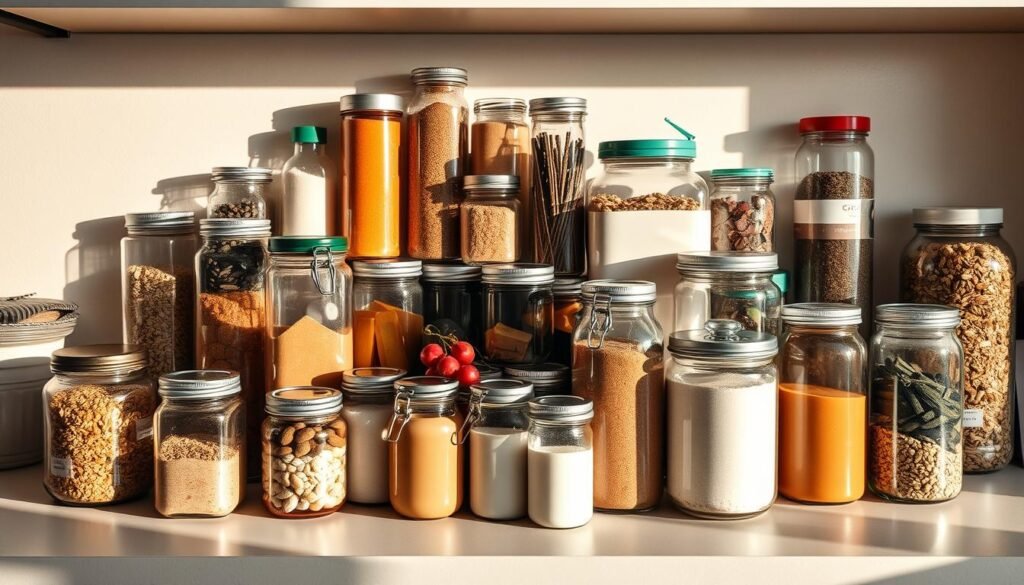
Stocking your kitchen efficiently is key to reducing waste and saving time. Effective inventory management ensures that you have the necessary ingredients on hand without overstocking, which can lead to waste and unnecessary expense.
The FIFO Method: First In, First Out
The FIFO method is a simple yet effective way to manage your food inventory. It ensures that older items are consumed before they expire, reducing waste. To implement FIFO, place newer items behind older ones in your storage containers.
Benefits of FIFO: Reduced waste, fresher ingredients, and a more organized kitchen.
Setting Minimum Stock Levels for Staples
Setting minimum stock levels for staples prevents running out of essential ingredients during meal preparation. Determine the minimum quantity of each staple you’re comfortable having before restocking. Consider factors like usage frequency, replacement time, and seasonal availability.
| Staple Item | Minimum Stock Level | Reorder Point |
|---|---|---|
| Flour | 2 bags | 1 bag |
| Sugar | 1 bag | 0.5 bag |
| Rice | 3 lbs | 2 lbs |
By implementing these strategies, you’ll maintain a well-stocked kitchen that’s both efficient and cost-effective. Regularly review your inventory to adjust stock levels as needed.
Building a Well-Stocked Pantry Step by Step
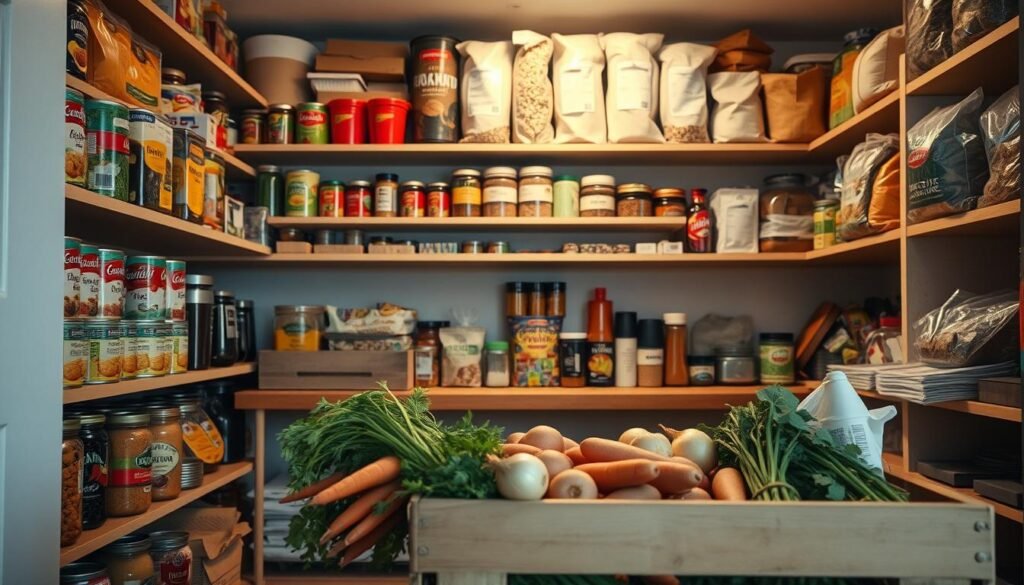
A thoughtfully stocked pantry is the key to unlocking quick and easy meal solutions. By implementing a strategic inventory system, you’ll save time during meal prep and reduce food waste. Let’s break down the process into manageable steps.
Starting with Long-Shelf-Life Staples
Begin by stocking up on long-shelf-life staples such as rice, pasta, and canned goods. These items form the foundation of your pantry and can be used in a variety of dishes. Buying in bulk can be cost-effective, but ensure you have adequate storage space.
Adding Versatile Ingredients
Next, add versatile ingredients that can be used across multiple meals. Spices, oils, and condiments are essential for adding flavor to your dishes. Consider your family’s taste preferences when selecting these items.
Incorporating Ready-to-Eat Meal Components
Finally, incorporate ready-to-eat meal components into your pantry inventory. Canned beans, pasta sauce, and soup bases can be quickly combined to create a satisfying meal. Having these components on hand saves you from relying on last-minute takeout or grocery runs, aligning with your overall strategy to save time and money.
By following these steps, you’ll have a well-stocked pantry that makes meal prep a breeze, allowing you to create a variety of food dishes with ease.
Smart Shopping Techniques for Efficient Food Stocking
Smart shopping is the backbone of a well-stocked kitchen. To maintain an efficient food stocking system, you need to adopt strategies that ensure you’re buying the right items at the right time. This involves understanding your kitchen’s inventory needs and planning your shopping trips accordingly.
Creating Shopping Lists Based on Inventory Gaps
Start by assessing your current inventory. Identify what’s missing and what’s nearing expiration. Create a shopping list based on these gaps to ensure you’re restocking efficiently. This approach helps prevent overbuying and reduces food waste.
Strategic Bulk Buying: When It Makes Sense
Buying in bulk can be cost-effective, but it’s only beneficial if you have the storage space and will use the items before they expire. Consider your shopping list and check if buying in bulk makes sense for certain items. For instance, pantry staples, cleaning supplies, and paper products are good candidates. However, for perishable food, be cautious and calculate the per-unit cost to ensure you’re truly saving money.
- Check if you have enough storage space for bulk purchases.
- Calculate the per-unit cost to ensure savings.
- Consider splitting bulk buys with friends or family.
By adopting these smart shopping techniques, you’ll be able to maintain a well-stocked kitchen efficiently, saving you time and reducing costs. Visit stores like Costco or Azure Standard for bulk shopping options, and always check local co-op stores for deals.
Seasonal Food Stocking Considerations

Your food stocking plan shouldn’t remain static; it needs to evolve with the seasons. As the seasons change, so do your kitchen’s needs, from the types of produce available to the demands of holiday cooking.
Adjusting Your Inventory for Seasonal Produce
One of the key aspects of seasonal food stocking is adjusting your inventory to incorporate fresh, seasonal produce. This not only ensures your meals stay interesting and varied but also helps in getting the best value for your money as seasonal produce tends to be cheaper.
To make the most of seasonal produce, consider planning your meals around what’s available during different times of the year. For example, summer might bring an abundance of fresh vegetables and fruits, while winter could be the time for heartier, root-based dishes.
Holiday and Special Occasion Planning
Special occasions and holidays create unique demands on your food inventory. Planning ahead is crucial to prevent last-minute stress and overspending during these busy times.
- Start building your holiday food stock several weeks in advance, gradually adding non-perishable items to your regular shopping trips.
- Create a special occasion inventory list that includes items you only use during holidays or gatherings.
- Watch for sales on holiday baking items, specialty ingredients, and entertaining essentials throughout the year.
By doing so, you’ll not only save money but also ensure that you’re prepared for any situation, including times of crisis when food sources might be limited. Having a well-stocked pantry during busy holiday seasons gives you the flexibility to focus on enjoying time with loved ones.
Food Storage Solutions to Maximize Freshness
When it comes to keeping your food fresh, the right storage solutions can make all the difference. Proper storage techniques not only extend the shelf life of your food inventory but also help maintain its quality, reducing waste and saving you time and money.
Proper Storage Techniques for Different Food Types
Different types of food require specific storage conditions to maintain their freshness. For instance, storing fruits and vegetables in separate compartments can help prevent moisture from affecting their quality. Using airtight containers for grains and cereals can keep them fresh for longer by protecting them from pests and moisture.
Extending Shelf Life with Preservation Methods
Beyond basic storage techniques, learning simple preservation methods can dramatically extend the shelf life of your food inventory. Techniques such as freezing, dehydrating, and canning allow you to enjoy seasonal produce year-round while minimizing waste.
- Freezing is one of the easiest preservation methods—blanch vegetables briefly before freezing to maintain color, texture, and nutrients for months.
- Dehydrating fruits, vegetables, and herbs concentrates flavors while creating shelf-stable ingredients that take up minimal storage space in your pantry.
- Simple water bath canning allows you to preserve high-acid foods like tomatoes, pickles, jams, and jellies without special equipment beyond canning jars and a large pot.
By implementing these preservation methods, you can significantly reduce food waste and enjoy a more sustainable kitchen.
Inventory Tracking Systems for Home Kitchens
A well-organized kitchen starts with a robust inventory tracking system. Managing your kitchen inventory efficiently can save you time, reduce waste, and make meal planning a breeze. Whether you’re a culinary enthusiast or a busy home cook, keeping track of your ingredients and supplies is crucial.
Simple Paper-Based Tracking Methods
For those who prefer a low-tech approach, a simple paper-based system can be an effective way to track your kitchen inventory. You can use a notebook or a binder to keep a list of your ingredients and supplies. This method allows you to manually update your inventory and can be a good starting point for those new to inventory management.
Digital Apps and Tools for Food Inventory Management
Digital apps offer a convenient and efficient way to manage your kitchen inventory. Apps like Out of Milk and Yummly allow you to track your ingredients, create shopping lists, and even plan meals based on what’s in your pantry. These tools are accessible on your smartphone or tablet, making it easy to update your inventory on the go.

Setting Up Reorder Alerts
Reorder alerts are a crucial feature of any inventory management system, ensuring that you never run out of essential ingredients. By setting up reorder alerts, you can receive notifications when items reach their minimum stock levels. This proactive approach helps you maintain adequate food supply without the stress of emergency shopping trips.
- Never run out of essential ingredients again by setting up a reorder alert system that notifies you when items reach their minimum stock levels!
- Whether using a digital app or a simple paper system, establish clear triggers that prompt you to add items to your shopping list before you completely run out.
- For staple items you use frequently, consider setting up automatic delivery subscriptions through services like Amazon Subscribe & Save or local grocery delivery options.
- Your reorder alert system should account for how long it typically takes to replace items—everyday essentials might need higher alert thresholds than specialty products.
- This proactive approach to inventory management ensures you maintain adequate food supply without the stress of emergency shopping trips.
Reducing Food Waste Through Strategic Stocking
By adopting a strategic approach to food stocking, you can significantly reduce waste in your kitchen. This not only saves you money but also contributes to a more sustainable lifestyle. Effective inventory management is key to achieving this goal.
Meal Planning Based on Inventory
One of the most effective strategies for reducing food waste is to plan your meals around what’s already in your inventory. Take stock of your ingredients and think creatively about how to use them. This approach not only reduces waste but also challenges your cooking skills.
Creative Ways to Use Leftovers and Aging Ingredients
Transforming leftovers into new dishes is a practical skill that showcases your innovation in the kitchen. Consider turning last night’s dinner into tomorrow’s lunch or using leftover vegetables to make a hearty soup. You can also repurpose aging ingredients into delicious meals. For instance, almost-wilted vegetables can be transformed into stir-fries or frittatas, while overripe fruits make excellent smoothies or baked goods.
Some other ideas include creating a weekly “clean out the fridge” meal where you use up whatever ingredients need attention. Keeping a container in your freezer for vegetable scraps to make homemade stock is another great way to reduce waste. By adopting these practices, you’ll not only reduce food waste but also enhance your cooking skills and contribute to a more sustainable kitchen.
Building Relationships with Local Food Suppliers
As you optimize your kitchen, consider the benefits of forging relationships with local food suppliers. By doing so, you can gain access to fresh, high-quality products while supporting your community. This connection can help you maintain a well-stocked inventory with the best seasonal produce.
Finding and Supporting Local Farmers and Producers
Finding local farmers and producers is easier than you think. Start by visiting your nearest farmer’s market or searching online for local farms that offer community-supported agriculture (CSA) programs. You can also ask friends, family, or coworkers for recommendations. By supporting local agriculture, you’re not only getting the freshest food, but you’re also contributing to the local economy and reducing your carbon footprint.
Joining Food Co-ops and Community Supported Agriculture
Food co-ops and CSA programs offer excellent opportunities to access quality food at lower prices while building community connections. With a CSA subscription, you typically pay upfront for a share of a farm’s harvest, receiving regular deliveries of fresh, seasonal produce—perfect for maintaining a varied food inventory. Many food co-ops also provide bulk purchasing options, helping you stock up efficiently on staples and reducing your overall cost.
By joining forces with others in your community through these programs, you gain purchasing power that can reduce costs while supporting sustainable food production and strengthening local food security. This collaborative approach to food supply can be a cost-effective way to maintain a diverse and healthy food inventory.
Conclusion: Maintaining Your Food Stocking System Long-Term
Now that you’ve set up your food stocking system, it’s time to focus on maintaining it. Consistency and periodic reassessment are key to ensuring your system continues to work efficiently.
To avoid discouragement, start by setting small, achievable goals. Begin with a two-week supply and gradually work your way up to a one-month or six-month supply. This approach will help you develop the habit of properly rotating and managing your food storage.
Schedule regular inventory reviews, perhaps monthly or quarterly, to identify areas for improvement. Be patient with yourself as you develop these habits; building an effective food management system takes time.
Remember, your food stocking strategy should adapt to your changing needs and circumstances. Celebrate the benefits you experience, such as less food waste, more efficient shopping trips, and lower grocery bills.
By maintaining your food stocking system, you’ll enjoy the peace of mind that comes from having a well-stocked kitchen ready for whatever life brings. With time, your inventory management will become second nature, requiring less conscious effort while continuing to save you time and stress.
FAQ
How often should I assess my kitchen inventory?
You should assess your kitchen inventory regularly, ideally every 1-3 months, to ensure you’re not overstocking or understocking on essential items. This frequency also helps you adjust to changing seasonal produce and your household’s consumption patterns.
What’s the best way to store perishable items to maximize their shelf life?
To maximize the shelf life of perishable items, store them in airtight containers and keep them in the right conditions. For example, store fruits and vegetables in separate drawers in your refrigerator, and keep dairy products at a consistent refrigerator temperature below 40°F.
How can I efficiently manage my pantry to avoid expired or spoiled products?
To efficiently manage your pantry, implement the FIFO (First In, First Out) method, where you place newer items behind older ones. Regularly check expiration dates, and consider using a pantry inventory tracking system, either digitally or on paper, to stay on top of your stock.
What are some smart shopping techniques for efficient food stocking?
Smart shopping involves creating shopping lists based on your inventory gaps, buying in bulk when it makes sense, and taking advantage of sales on non-perishable items. It’s also beneficial to shop for seasonal produce to get the best quality and price.
How can I reduce food waste through strategic stocking?
Reducing food waste can be achieved by meal planning based on what you already have in stock, using up leftovers creatively, and understanding the shelf life of different products. Regular inventory checks help you stay aware of what’s approaching its expiration date.
What are the benefits of building relationships with local food suppliers?
Building relationships with local suppliers can provide you with fresher produce, support the local economy, and sometimes offer better prices or more flexible purchasing options. It also opens up opportunities to learn about new products and seasonal availability directly from the source.
How do I choose the right storage containers for my kitchen?
When choosing storage containers, consider the type of food you’re storing, the space available in your kitchen, and the material of the containers. Airtight containers made from glass or BPA-free plastic are versatile and can be used for a variety of foods, from dry goods to leftovers.
What’s the best inventory tracking system for a home kitchen?
The best inventory tracking system for a home kitchen can be as simple as a notebook or as advanced as a digital app. The key is to choose a method that you’re comfortable with and that fits your kitchen’s needs, allowing you to easily track what’s in stock and what’s running low.
